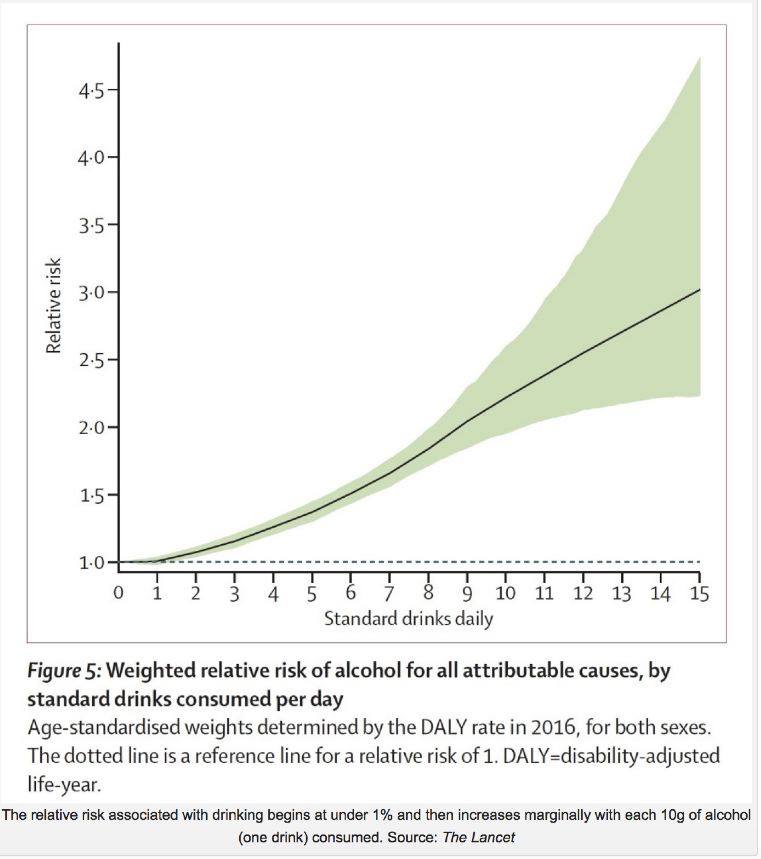Research Published in 2018 that did not Support Light to Moderate Drinking as a Healthy Lifestyle Choice
“One glass of wine a day can shorten your life”
A United Kingdom media story
The most controversial news regarding alcohol and health in 2018 was the study published in The Lancet in
August titled, “No level of alcohol consumption improves health.” This report was a meta-analysis of 694 data
sources on individual and population-level alcohol consumption, 592 retrospective studies on the risk of alcohol
use and data from the 2016 Global Burden of Diseases, Injuries and Risk Factors Study. The report involved
195 countries and territories. The results indicated that very moderate drinking - about one drink a day -
lowered the rate of certain kinds of heart attacks but the risk of other cardiovascular problems and the risk of
cancers and other illnesses outweighed the benefit. Overall, researchers found that any amount of alcohol use
was linked to worsening health conditions and the more people drink, the more likely they will face negative
health consequences. The paper’s authors said, “The level of consumption that minimizes health loss is zero.
One or two drinks a day aren’t healthy. The best amount of alcohol to drink is no alcohol at all.”

The Lancet study led to sensational press claims that there was no safe level of alcohol consumption, and
caused considerable pushback from the scientific community. Christopher Snowden wrote in Spectator Health
that the press releases were misleading and did not explain that the control group was made up of moderate
drinkers rather than abstainers. He said, “The quotes given to the press were focused more on the lowering of
the U.K. guidelines than explaining the study’s findings. It had the hallmarks of fake news.” It was pointed out
that the study did not acknowledge that countries with higher alcohol consumption have higher life
expectancies while those with lower consumption have lower life expectancies. Professor Sir David
Spiegelhalter of the University of Cambridge retorted, “There is no safe level of living, but nobody would
recommend abstention.” Vinay Prasad, Assistant Professor of Medicine at the Oregon Health and Sciences
University characterized the study as “wonky speculative conclusions of a genre of utter rubbish
nutritional epidemiology research.”
The ISFAR critique pointed out that it is problematic to attempt to combine data from many divergent cultures
to determine a single association between alcohol consumption and health. The authors’ statement that zero
consumption would be preferable everywhere is sharply contradicted by consistent reports from very large,
well-done cohort studies which indicate that non-drinkers have higher risks of CVD and total mortality than
regular moderate drinkers who do not binge drink. The paper’s overall results have little applicability in setting
guidelines that would lead to avoidance of alcohol abuse in any specific group of people around the world as
they apply to no specific population. “If one looks at all the data, the study doesn’t tell us anything we did
not already know. Moderate drinking reduces mortality risk and is particularly good for the heart. Light
drinkers have the best outcomes, but drinkers who consume in moderation do better than those who
do not drink at all.”
A study published in October 2018 in Clinical & Experimental Research associated daily drinking with
increased mortality. Two data sets with self-reporting use and mortality follow-up were analyzed from the
National Health Interview Survey (NHIS). The minimum risk of low-level drinking frequency for all-cause
mortality appeared to be approximately 3 occasions weekly. The authors of this study concluded that daily
drinking, even at low levels, is detrimental to one’s health.
There were several articles in the press in 2018 about the effects of wine and teeth staining, enamel erosion,
cavities and more. Known as “wine teeth” or “wine mouth,” staining of the teeth can be due to red or white wine
since white wine has more acidity and more tendency to break down enamel, leaving teeth more vulnerable to
pigmented food and drinks. The vulnerability to tooth staining is variable and determined by the health of one’s
teeth enamel. Good teeth hygiene is important since plaque can cause more teeth staining. Drinking white
wine before red wine can worsen teeth staining. Red wines like Cabernet Sauvignon, Merlot and Malbec have
more pigment, more tannin and produce more staining, while Pinot Noir produces less. One article in Seven
Fifty Daily in 2018 revealed how drink professionals practice good dental hygiene. They recommend minimizing
contact time between teeth and wine by rinsing with water soon after consuming. Swishing with water can
remove potential stains, restore normal pH in the mouth and stimulate the flow of saliva. Strips of damp paper
towels can be used to wipe off stains on the teeth. A tongue scraper can be used to improve taste sensation
and reduce the loss of sensitivity of taste buds over time. Chewing xylitol gum can lower acid in the mouth and
stimulate saliva production, and thereby can help prevent erosion. Some recommend remineralizing kinds of
toothpaste and fluoride treatment every six months. Brushing should be avoided for at least 30 minutes after
the last taste of wine because it can push acid into the teeth and cause more damage. High sugar wines such
as some bottlings of Prosecco can lead to tooth decay. the combination of acid, sugar and alcohol can produce
the “Prosecco smile,” seen as teeth coming out of the gum starting with a white line just below the gum that is
the beginning of tooth decay.



